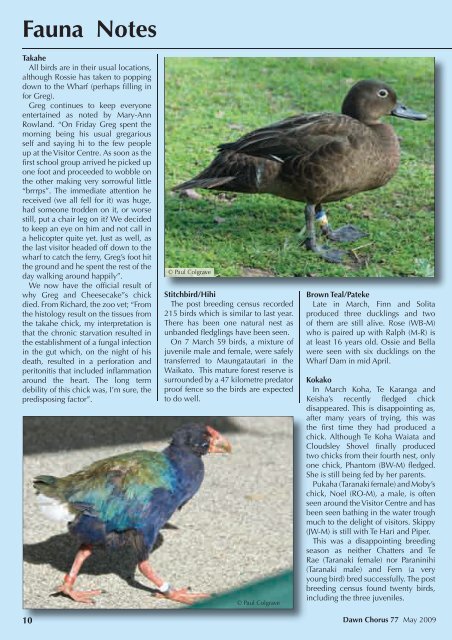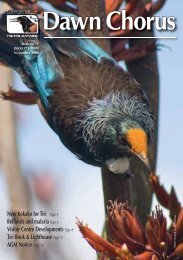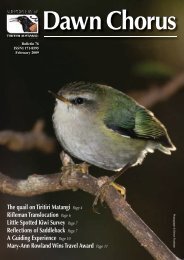Dawn Chorus - Tiritiri Matangi
Dawn Chorus - Tiritiri Matangi
Dawn Chorus - Tiritiri Matangi
You also want an ePaper? Increase the reach of your titles
YUMPU automatically turns print PDFs into web optimized ePapers that Google loves.
Fauna Notes<br />
Takahe<br />
All birds are in their usual locations,<br />
although Rossie has taken to popping<br />
down to the Wharf (perhaps filling in<br />
for Greg).<br />
Greg continues to keep everyone<br />
entertained as noted by Mary-Ann<br />
Rowland. “On Friday Greg spent the<br />
morning being his usual gregarious<br />
self and saying hi to the few people<br />
up at the Visitor Centre. As soon as the<br />
first school group arrived he picked up<br />
one foot and proceeded to wobble on<br />
the other making very sorrowful little<br />
“brrrps”. The immediate attention he<br />
received (we all fell for it) was huge,<br />
had someone trodden on it, or worse<br />
still, put a chair leg on it? We decided<br />
to keep an eye on him and not call in<br />
a helicopter quite yet. Just as well, as<br />
the last visitor headed off down to the<br />
wharf to catch the ferry, Greg’s foot hit<br />
the ground and he spent the rest of the<br />
day walking around happily”.<br />
We now have the official result of<br />
why Greg and Cheesecake”s chick<br />
died. From Richard, the zoo vet; “From<br />
the histology result on the tissues from<br />
the takahe chick, my interpretation is<br />
that the chronic starvation resulted in<br />
the establishment of a fungal infection<br />
in the gut which, on the night of his<br />
death, resulted in a perforation and<br />
peritonitis that included inflammation<br />
around the heart. The long term<br />
debility of this chick was, I’m sure, the<br />
predisposing factor”.<br />
10<br />
© Paul Colgrave<br />
Stitchbird/Hihi<br />
The post breeding census recorded<br />
215 birds which is similar to last year.<br />
There has been one natural nest as<br />
unbanded fledglings have been seen.<br />
On 7 March 59 birds, a mixture of<br />
juvenile male and female, were safely<br />
transferred to Maungatautari in the<br />
Waikato. This mature forest reserve is<br />
surrounded by a 47 kilometre predator<br />
proof fence so the birds are expected<br />
to do well.<br />
© Paul Colgrave<br />
Brown Teal/Pateke<br />
Late in March, Finn and Solita<br />
produced three ducklings and two<br />
of them are still alive. Rose (WB-M)<br />
who is paired up with Ralph (M-R) is<br />
at least 16 years old. Ossie and Bella<br />
were seen with six ducklings on the<br />
Wharf Dam in mid April.<br />
Kokako<br />
In March Koha, Te Karanga and<br />
Keisha’s recently fledged chick<br />
disappeared. This is disappointing as,<br />
after many years of trying, this was<br />
the first time they had produced a<br />
chick. Although Te Koha Waiata and<br />
Cloudsley Shovel finally produced<br />
two chicks from their fourth nest, only<br />
one chick, Phantom (BW-M) fledged.<br />
She is still being fed by her parents.<br />
Pukaha (Taranaki female) and Moby’s<br />
chick, Noel (RO-M), a male, is often<br />
seen around the Visitor Centre and has<br />
been seen bathing in the water trough<br />
much to the delight of visitors. Skippy<br />
(JW-M) is still with Te Hari and Piper.<br />
This was a disappointing breeding<br />
season as neither Chatters and Te<br />
Rae (Taranaki female) nor Paraninihi<br />
(Taranaki male) and Fern (a very<br />
young bird) bred successfully. The post<br />
breeding census found twenty birds,<br />
including the three juveniles.<br />
<strong>Dawn</strong> <strong>Chorus</strong> 77 May 2009







